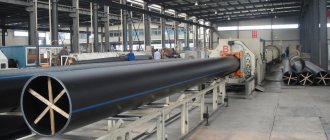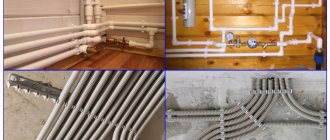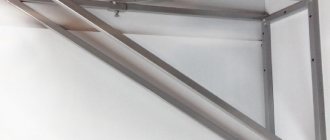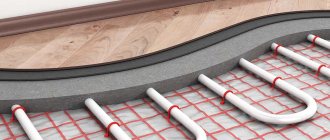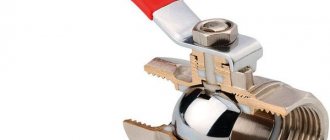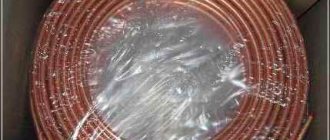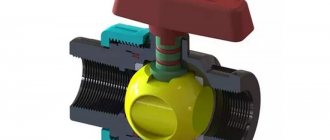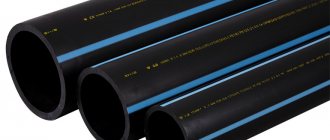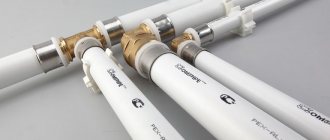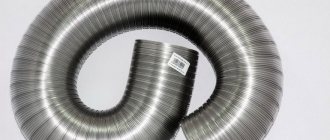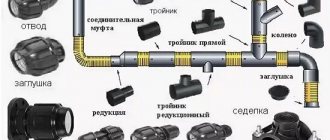Good day, dear reader! External cable lines and electrical wiring inside the house require additional insulation, which will protect the cable from external influences, and residents from electric shock if its insulating layer is damaged. HDPE cable pipe copes well with this task. In this article I will talk about the features of these products, the existing varieties and different installation methods.
Specifications
- Permissible operating temperature is from -25 ºС to +70 ºС.
- The permissible installation temperature is not lower than -30 ºС.
- The density of polyethylene is 0.949–0.953 g/cm3.
- Flammability class - B1, B2.
- Nominal pressure depending on the type of pipes: light - 0.25 MPa; medium-light - 0.4 MPa; average - 0.6 MPa; heavy - 1 MPa.
- Thermal expansion coefficient is 0.15–0.2 mm/mºK.
- The brittleness temperature is from –70 ºС.
Areas of application
HDPE pipes are used as protective sleeves for cables laid in open, hidden and semi-hidden ways when installing:
- power supply networks;
- telephone lines;
- telecommunications;
- video surveillance;
- computer networks;
- fire, control, emergency alarms.
Reasons for high popularity
When performing electrical installation work, HDPE pipe is very popular for a number of reasons:
- It provides reliable protection for cables, virtually eliminating the risk of electric shock if the cable insulation is damaged.
- It has a special design that makes it easier to pull all types of cables.
- HDPE pipe products, unlike metal boxes, are more convenient to transport and are absolutely not susceptible to corrosion.
- Does not conduct electric current, therefore does not require additional costs for cathodic protection.
Life time
The service life of HDPE pipes for cable is at least 50 years.
Requirements and Standards
The requirements for the technical characteristics of cable ducts made of HDPE pipes are regulated by GOST 32126.1–2013. Recycled material grades must comply with:
- GOST 16338-85. The standard applies to low-density polyethylene of the following grades: 271, 273, 276, 277, 286.
- GOST 16337-85. Determines the technical requirements for high-density polyethylene grades 10803-020, 15303-003, 15803-020, 16803-170.
The outer surface of the HDPE technical pipe must be smooth, without noticeable peeling, cracks, chips and bubbles. The internal surfaces of the products should not have bumps or protrusions that would prevent the wire from being pulled through.
Polyethylene pipes are sold in lengths of 5–12 meters or in coils of 25, 50, 100, 200 meters.
Marking
The marking is applied by the manufacturer on the outside of the HDPE pipe along its entire length in 1-meter increments. It consists of the following notations:
- manufacturer's name (trademark);
- brands of polyethylene (for example, PE-63, PE-80);
- SDR indicator (the ratio of the outer diameter of the product to the wall thickness). It determines the level of ring strength;
- geometric parameters: diameter and wall thickness;
- production standard (GOST or TU);
- purpose of the product (technical, drinking, gas or sewer);
- production dates.
I give an example of a typical marking: PE63 SDR 11 - 40*2 technical GOST 16338-85.
PND - decoding or what it is
The abbreviation HDPE stands for simply: low-density polyethylene (you can find HDPE - it means the same thing as HDPE). The material is highly dense and is the end product of the polymerization reaction of polyethylene at low pressures. It is gray-transparent, hard, and is used as a raw material for the production of pipes for various purposes. These properties are explained by the special structure of the substance, the intermolecular bonds of which provide a higher density in comparison with other polyethylene analogues. It is also called high-density polyethylene (HDPE).
Classification of HDPE pipes for cable laying
Manufacturers offer HDPE pipes for installation of cable ducts in two versions:
- smooth;
- with corrugated wall.
These types of pipe products differ in technical characteristics and are used for operation in different conditions.
Smooth
Smooth HDPE pipes are black, rigid, and have high mechanical strength. They are:
- Non-reinforced walls with a single-layer structure. Used for laying cables in brick walls, concrete structures, floor screeds.
- Double-layer reinforced. Used for operation in more difficult conditions.
For turns and transitions in cable ducts made of smooth HDPE pipes, special fittings are used.
Corrugated
Polyethylene corrugated pipes are used for the installation of both surface and underground communications. They have a two-layer wall, in which the inner layer is smooth, made of LDPE, and the outer corrugated one is made of HDPE. Can be supplied with or without an internal probe.
Based on their ability to withstand external pressure they are divided into:
- easy;
- average;
- heavy look.
Depending on the purpose they are painted in different colors:
- red - for high-voltage routes;
- blue - for laying communication lines and telecommunications;
- black - general purpose products.
HDPE corrugated pipes are distinguished by excellent flexibility, can withstand heavy loads, and therefore can be used for laying curved mains and placed at different depths.
Requirements
For cables laid above ground or in trenches, a rigid protective frame must be provided. Therefore, pipes must have excellent strength, rigidity and resist the effects of precipitation.
In addition, in order to prevent the possibility of emergency situations occurring during a short circuit, the protective casing must have high fire-retardant properties.
To make it easier to pull the cable into the pipe, its inner surface should have protrusions and bumps. In some cases, the electrical HDPE pipe is equipped with a cable for pulling the cable, which greatly speeds up the process of laying it.
Advantages and disadvantages
HDPE pipes for cable protection have the following advantages:
- Light weight compared to metal hoses.
- Good electrical insulating properties.
- Resistant to chemicals.
- High degree of wear resistance.
- Ability to withstand prolonged contact with an aggressive environment.
- Low thermal conductivity, due to which condensation does not form.
- Frost resistance. Pipes do not collapse when water freezes in them.
- Affordable price. For electrical work, pipes made from recycled materials are used, the cost of which is 30–50% lower than products made from primary polymer granules.
- Elasticity. It can be bent in difficult areas without using shaped parts.
- The smoothness of the inner walls makes it easy to pull the cable through.
- Sufficient rigidity.
- Bacteriological resistance.
- Resistance to mechanical damage and vibration loads.
- Low coefficient of linear expansion.
- Resistance to temperature changes.
Disadvantages include the ability of HDPE pipes to support and spread combustion. Therefore, they must be embedded inside fire-resistant materials, such as concrete screed, cement mortar, or laid in the ground.
Marking of low pressure polyethylene pipes
All HDPE pipes must be marked in accordance with the standards. Marking not only allows you to classify different types of pipes, but also makes it possible to control the quality of products - the applied markings are a guarantee of the suitability of the material for use.
Each pipe has symbols that display the trademark or full name of the manufacturing company. Labeling can be carried out according to national or international standards. The next element is the material of manufacture. For example, a pipe made of PE 80 is displayed as MRS 8. The pipe must also have a designation of the minimum wall thickness, outer diameter and nominal pressure (bar).
A separate paragraph may indicate the suitability of the pipe for constructing a gas pipeline network or transporting drinking water. The last marking point is the batch number and date of manufacture of the pipe.
HDPE pipes are divided into six classes, with the following designations:
- Heavy - T;
- Medium-heavy - ST;
- Medium-lightweight – OS;
- Average – C;
- Medium light - SL;
- Lungs – L.
Tips on how to choose
The following indicators should be the determining factors when choosing HDPE pipes for cable:
- Bandwidth. The internal diameter of the pipe must correspond in size to the total cross-sectional area of the cables that are supposed to be inserted into its cavity. The range of polyethylene pipe products includes products with a diameter from 16 to 225 mm and a wall thickness from 2 to 30 mm. If you need to stretch 2 wires with a cross-sectional area of 5 mm² each, then a pipe with an internal diameter of 20 mm will do. For 3 cables with a total cross-section of 24 mm², the optimal diameter will be 30 mm.
- Strength characteristics. To assess the strength level of a product, take the SDR value in the labeling. The lower it is, the stronger the pipe and can withstand greater loads.
Methods and rules for laying HDPE pipes
The technology for laying protective sleeves from HDPE pipes has features depending on the location of the cable and its operating conditions.
The general rules for all installation methods are as follows:
- It is not recommended to lay cables of different networks in the cavity of one protective channel.
- Do not bend the pipe at an acute angle, as this may lead to the formation of a crease.
- The joints between the pipes must be sealed. Individual products can be connected using compression couplings, press fittings or butt welding.
- The length of the section between the boxes should not exceed 25 meters.
- When laying openly outside the building, black HDPE corrugation, resistant to ultraviolet radiation, should be used.
- To ensure the drainage of condensate formed on external surfaces, the pipelines must have a slope directed towards the duct boxes. Moisture will collect in them.
- When the channel is buried more than 2 meters into the soil, it is necessary to place a protective concrete screed 8–10 cm thick on top.
Laying pipes inside buildings
Installation of cable channels inside buildings is carried out in the following order:
- Cable routing markings.
- Punching grooves in the building envelope (if necessary).
- Connecting individual HDPE pipes into a pipeline and fixing them. To fasten products to walls or ceilings, special holders with a latch are used; to the floor, metal brackets are used.
- Sealing of the structure depending on the location of the channel and its diameter. To seal the walls, use plaster or other finishing materials. Pipelines laid in the floor are poured with concrete.
- Cable pulling. The wire inside the plastic pipeline should be positioned freely, without tension.
Laying outdoors in a trench
In many cases, underground installation of electrical cables is preferable to overhead routes. In the ground it will be protected from precipitation, icing and gusts of wind, and will be inaccessible to thieves of non-ferrous metals.
The process of laying HDPE pipes for cables in the ground consists of the following steps:
- marking the dimensions of the trench;
- trench excavation and bottom leveling;
- laying out pipes along the trench;
- backfilling the base of the ditch with sand or soft soil 10 cm;
- sequential laying of pipe sections with sealing of joints by resistance welding;
- checking the integrity of the cable sheath and pulling it into the pipe cavity without tension;
- backfilling the finished pipeline with soft soil or sand with a layer thickness of 10–15 cm;
- backfilling the trench with soil.
So that the laid route can be found in the future, signal posts are placed above it. When installing cables underground, fittings cannot be used to connect parts of a polyethylene pipeline. They can break its tightness.
Trenchless method of laying in the ground
In cramped conditions of private courtyards or dachas, where it is not possible to dig a trench, a trenchless cable laying method is used. To do this, special equipment is used that allows you to drill the soil in a horizontal direction. Before starting work, you need to obtain a drilling permit and perform an analysis of the geological composition of the soil.
Cable laying using the trenchless method is carried out in the following sequence:
- Drilling a pilot well. It is performed using a special tip attached to a flexible rod. It allows you to change direction when encountering natural obstacles in the ground. The tip is equipped with special cooling holes and a navigation device. This allows you to control the drilling trajectory and correct its direction.
- Expansion of the well to the required size. At this stage, the tip is replaced with an expander, which makes it possible to increase the diameter of the well to the design parameters;
- Pipe laying. First, you need to insert a cable into the pipeline, and then attach the assembled structure to a special rod of the HDD installation, which will pull it through the well. To reduce the friction force when passing a line of communication through a horizontal channel, drilling fluid is used.
